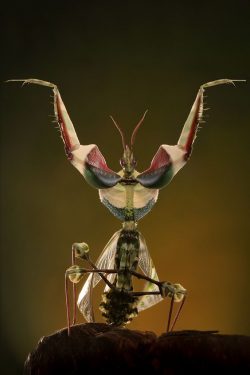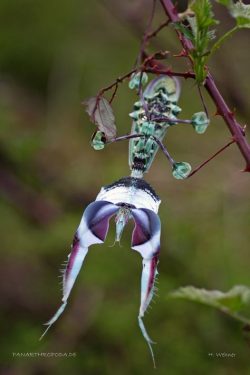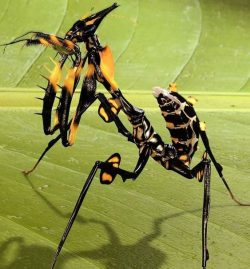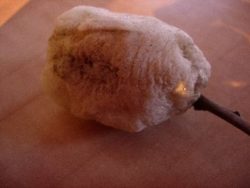 The Idolomantis Diabolica (Devils flower mantis), is sometimes known as the “King of all mantids” for the obvious reason; it’s beauty, size and rarity.
The Idolomantis Diabolica (Devils flower mantis), is sometimes known as the “King of all mantids” for the obvious reason; it’s beauty, size and rarity.
Looks
This species is another one of the very many flower mimics. With it’s bright green wing case, centred with a large, coloured, ocellus. With leafy projections on the legs, and green/brown body colouring, this species is a true master of disguise. Both sexes possess fully grown wings, covering the whole abdomen. Sex determination is the usual, 8 segments for the male, and 6 or 7 for the female. Another sexual dimorphism is the difference on appearance of the antennae. The males have more feathery, split antennae, and the females long, thin and straight.
The Idolomantis is famous for it’s beautiful threat pose, showing off a deep purple and green colouration around it’s legs.
In captivity, Idolomantis diabolica is known for being an expensive species, mainly due to it’s difficulty to raise, with nymphs temperamental to fluctuations in conditions. The Devils Flower Mantis originates from regions around Tanzania.
Idolomantis diabolica Behaviour
Despite it’s size and beauty, the Idolomantis diabolica is a nervous species, from young nymphs to adults. Nymphs will often run around, and appear somewhat scatty when disturbed, and will often totally lose co-ordination. Famous for it’s threat pose, this is typical behaviour of adult Devils flower mantises, and is an attempt to scare off prey.
Whilst showing signs of diametic behaviour (showing off colour in order to scare), adult Idolomantis will also open their wings to appear larger, more colourful, and more threatening to predators.
 Humidity and Temperature
Humidity and Temperature
The Idolomantis requires a slightly more advanced keeping than most species. Originating from Tanzania, it would be exposed to very high temperatures, likewise with humidity. In captivity, we try to do the best to stimulate these conditions.
30-40C is the best temperature range to be keeping the Idolomantis diabolica. Temperatures lower than 30c throughout the day are not recommended, and will contribute to slower growth. Nighttime temperatures can drop to the low 20s. The best way of achieving the higher temperatures is with a heat bulb – and if kept communally – you will find your Devils flower mantises grouping around the heat lamp.
Higher humidity is needed, so a daily spray will be required. However it’s important to ensure that your Idolomantis diabolica are well ventilated. The best way to achieve this is having mesh top or sided enclosures, to ensure a constant air flow through the tank.
This species has a very complex structure, as with many other mimic species, which can prove a problem when shedding. Frequent spraying will soften the skin, making removal a lot quicker, and easier. Having high temperatures also helps when spraying, as all standing water will be evaporated within a few hours.
Housing and Enclosure
Being one of the largest of all species, the Idolomantis Diabolica is a true beast. Due to its size, the enclosure needs to be a big one. For shedding purposes, the height of the enclosure needs to be at least 3 times the length of the mantis. Any shallower, then it could lead to the mantis getting tangles in the exuvium. They are not a very active species, so an overly large enclosure is not necessary. They will often spend days sitting in the same spot, either as a form of disguise, or in a warm light.
Foliage must be put in the enclosure, as after all, the Idolomantis is a flower mimicking species. Silk plants are the best form of foliage to use, as these are 100% free from any toxins. Also provide some twigs, and other branches, for hanging purposes. When kitting out the enclosure, make sure it is not over crowded. It is best to leave on side of the tank virtually free of foliage, to provide room for the shedding of skin. When adult, this does not matter, as the mantis will not under go any more shedding of skin.
It is advised to use a substrate, as for any exotic mantis species. Not only does it add to the look of the enclosure, but also it helps to keep humidity levels high. The most effective substrate is soil or peat. Also, a layer of compressed coconut fibre is a great substrate, as this is very clean, and you can be assured no form of pesticide or any other harmful chemicals will be present. This is especially good for the Idolomantis, as they do require very high humidity levels.
You can fairly easily house your Devils flower mantises communally, provided there is ample food to keep them well fed.

Idolomantis feeding and diet
The diet is one of the harder aspects of keeping the Idolomantis. They feed primarily on flying insects in the wild throughout Tanzania, and it’s recommended to try and replicate this diet as much as possible. Houseflies, moths, butterflies, beetles, lacewings, and any other flying insect available. They will not take to ground dwellers, such as crickets, locusts, mealworms, and the standard live food that is readily available in the local pet store. Not only does the mantis not take to these feeders, but also they are unsuitable to use as a staple diet, especially when breeding.
Devils flower mantis need a constant supply of food, so ensure that flying prey is readily available to eat. Try and get a good balance – overcrowding the enclosure will cause stress to the mantis, and could lead to issues with moulting.
Different sizes require different sizes of food. From about L4, they will readily take small houseflies. Any smaller, they should be fed on fruit flies (D. Heidii) A large female will be able to take a hawk moth, but feeding gut loaded flies will be the best option.
Flies can be hatched out from maggots bought in pet stores, and gut loaded. For gut loading the flies, there is a very simple method. Keep the pupae in an airy container, covered in a fine mesh lid. Keep the container warm, but do not spray the pupae. As the flies start hatching, lay pieces of kitchen roll, soaked in warm water a honey mixture, on top of the mesh lid. The flies will feed off this, and after about 3 days of this, they will have a suitable nutritional content to feed to the mantis.
Wild caught insects will not need to be gut loaded, as they will have had a natural gut load in them already.
 Breeding Idolomantis Diabolica
Breeding Idolomantis Diabolica
One of the biggest issues with breeding this species is getting a mature male and female at the same time. Similarly to other species, if you’re looking to slow down the growth of males, simply drop the temperature compared to the females.
3 weeks or so after maturing into adults will be ample time to wait before introducing the male to the female. If you’re keeping your Idolomantis communally, then they should mate off their own accord when ready. As always, ensure your female is well fed if you’re manually introducing the male.
Up to 8 or so ootheca will be produced by your Idolomantis, roughly every 3-4 weeks or so. Larger ootheca can hatch upwards of 50 nymphs, so yields can be relatively larger.
Summary
A beautiful, skittish species that can be hard to come by. It’s recommended that unless you have an ample setup to cater for the temperature, humidity and dietary requirements of the Idolomantis diabolica, you should look to keep a slightly easier species.
Idolomantis diabolica links
Here are some useful links to other resources with information about Devils flower mantis:
Tree of Life Project – Idolomantis
Inaturalist – Idolomantis general info
Idolomantis diabolica nymphs and ootheca for sale
Please note that I am only able to source ootheca at the moment, you can buy them at the link at the top of the page. The waiting time is around 3 weeks (from May 8th). If you’re interested in these Idolomantis diabolica ootheca you can either contact me directly or buy from the link at the top of this page.
UPDATE: These are now sold out. If you are still interested in ootheca, then drop me a message via the contact form.



Idolomantis Diabolica (Devils Flower Mantis) – Caresheet, ootheca & for sale discussion:
Feel free to post any comments on this species below:
Live in southern part of Michigan and see these a lot they are really Kool they r welcome site as opposed to most insects